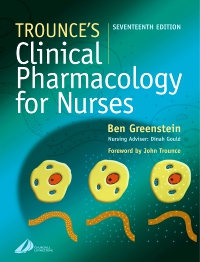
ISBN:
9780702059438
Copyright:
2005
Publication Date:
09-24-2004
Page Count:
400
Imprint:
Churchill Livingstone
List Price:
$43.95
Trounce's Clinical Pharmacology for Nurses - Elsevier eBook on VitalSource, 17th Edition
by Ben Greenstein, BA(Hons), BSc(Hons), DHPh, PhD, FBIH, MRPharmS and Dinah Gould, BSc, MPhil, PhD, DipN, RGN, RNT
Elsevier eBook on VitalSource

ISBN:
9780702059438
Copyright:
2005
Publication Date:
09-24-2004
Page Count:
400
Imprint:
Churchill Livingstone
List Price:
$43.95
Was
$43.95
Now $39.56
Or $0.00 with a valid access code
With the important part played by nurses in the administration of drugs and in recording their effects, and developments in nurse prescribing, an understanding of pharmacology and its application to patient care is an integral part of pre and post-registration nursing education. This popular textbook has two main aims:to give an up-to-date account of the action and use of drugs in the treatment and prevention of disease to explore the principles underlying drug usage The seventeenth edition of this highly successful textbook builds on the foundation of its predecessors by bringing the text fully up to date with developments in the world of clinical pharmacology and current trends in clinical practice. It introduces some important new drugs and describes their use in the management and prevention of disease. In particular the new 'biologic' drugs are presented for the first time. There is also a new chapter devoted to helping students organise their notes and cut down unnecessary material, making it easier to learn for exams. The book also includes detailed information on alternative treatments such as homoeopathy, herbalism.Trounce's Clinical pharmacology is suitable for a wide range of health care students including: diploma and degree nursing students and nurses studying for post-registration qualifications or continuing professional education
-
- Comprehensive coverage of all major drug classes gives a thorough grounding for clinical work.
- Highly readable text facilitates understanding of a complex subject.
- Learning objectives and summaries in each chapter facilitate learning.
- Nursing points and special points for patient education are highlighted throughout the text to link theory with practice.
- The book also includes detailed information on alternative treatments such as homoeopathy, herbalism.
- A glossary explains some of the very technical jargon in the field.
-
- The text has been thoroughly revised and updated in line with new drugs and current clinical practice
- The text has been reorganised and rewritten to simplify the presentation of information making it clearer and easier to assimilate
- The nursing points have been expanded
- Case studies help relate the theory to practice
- The new 'biologic' drugs are presented for the first time
- A useful chapter on summarizing drug notes for revision has been added
-
Foreword. Preface. Glossary. Introduction. The use of pharmaceuticals. The role of nurses in drug administration. Nurses and the pharmaceutical service. The autonomic nervous system, asthma, 5-hydroxytryptamine and migraine. Drugs acting on the heart. Drugs used for blood pressure. Atheroma and thrombosis: anticoagulants and thrombolytic agents. Drugs affecting the alimentary tract Emetics and anti-emetics, cough remedies, respiratory stimulants Narcotic analgesics. Anti-inflammatory drugs: treatment of arthritis and gout Drugs affecting the kidney and renal function. Endocrine system I: The hypothalamus-pituitary axis. Endocrine system II: Hormones and metabolism: thyroid, parathyroid glands, calcitonin and osteoporosis. Endocrine system III: Hormones and metabolism: insulin, diabetes mellitus and obesity. Endocrine system IV: Hormones and metabolism: the adrenal glands. Endocrine system V: Hormones and reproduction. CNS 1: General anaesthesia , local anaesthetics and resuscitation. CNS 2: Epilepsy and Parkinson's disease. CNS 3: Antipsychotics, anxiolytics and hypnotics. CNS 4: Antidepressants and dementias. CNS 5: Drug dependence (drug addiction). Chemotherapy I: Antibacterial drugs. Chemotherapy II: Antifungal and antiviral agents: treatment of HIV disease. Chemotherapy III: Sera and vaccines. Chemotherapy IV: Drugs used in the treatment of malignant disease. Chemotherapy V: Treatment of tropical and imported diseases; anthelmintics. Chemotherapy VI: Drugs and the eye Application of drugs to the skin, nose and ears. Vitamins, iron and treatment of anaemia. Drugs in pregnancy and at the extremes of age. Adverse reactions to drugs: testing of drugs and pharmacovigilance. Disinfectants and insecticides. Poisoning and its treatment. Herbal medicines (phytotherapy) and homeopathy. Appendix. Index
Was
$43.95
Now $39.56
Or $0.00 with a valid access code